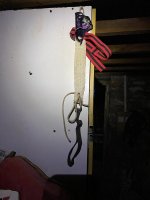I experimented with rope-walking many years ago – so long since that I can’t remember the exact set-up I was using. Anyway, I remember going up to Gaping Gill, tying a big thick length of Bluewater rope to a huge boulder near the lip of the shaft, feeding it down, installing a rope-protector over the edge and abbing straight down (such innocence in those days; re-belays? deviations? What are they?) I then rope-walked out in a reasonable time, though I can’t remember how long.
However, I did experiment at Alum Pot some time later, when the rebelays had been installed at the NW end. This time I timed myself. I abseiled down and rope-walked up to the rebelay in 7.5 minutes; I then went back down and ‘frogged’ it back up in 6.5 minutes. I’ve don’t doubt that this says more about my familiarity with the two techniques (i.e. familiarity with the Frog, unfamiliarity with rope-walking), rather than anything bout the inherent advantages of each system, nevertheless, I figured that even if I ‘improved’ my time with the latter system, it simply wasn’t worth it on account of the extra hassle – at least, for everyday caving in Britain. I daresay if you’re digging at the bottom of Titan or some such, it might be worthwhile sorting out a rope-walking system.
However, I did experiment at Alum Pot some time later, when the rebelays had been installed at the NW end. This time I timed myself. I abseiled down and rope-walked up to the rebelay in 7.5 minutes; I then went back down and ‘frogged’ it back up in 6.5 minutes. I’ve don’t doubt that this says more about my familiarity with the two techniques (i.e. familiarity with the Frog, unfamiliarity with rope-walking), rather than anything bout the inherent advantages of each system, nevertheless, I figured that even if I ‘improved’ my time with the latter system, it simply wasn’t worth it on account of the extra hassle – at least, for everyday caving in Britain. I daresay if you’re digging at the bottom of Titan or some such, it might be worthwhile sorting out a rope-walking system.




